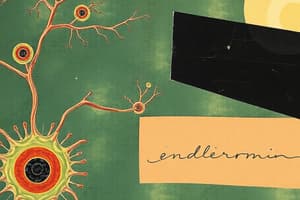Podcast
Questions and Answers
Define 'paracrine signaling' and give an example.
Define 'paracrine signaling' and give an example.
Paracrine signaling occurs when numerous cells simultaneously receive and respond to growth factors produced by a single cell in their vicinity. An example is local regulators in animals that stimulate nearby target cells to grow and multiply.
Explain how plant and animal hormones travel to target cells.
Explain how plant and animal hormones travel to target cells.
In animals, special endocrine cells release hormones into the circulatory system where they travel to target cells in other parts of the body. In plants, growth regulators (hormones) travel in vessels or from cell to cell or move through air by diffusion.
List and briefly define the three stages of cell signaling.
List and briefly define the three stages of cell signaling.
Reception is when a chemical signal binds to a cellular protein. Transduction is when binding leads to a change in the receptor, triggering a series of changes along the signal-transduction pathway. Response is when the transduced signal triggers a specific cellular activity.
Describe the nature of a ligand-receptor interaction and state how such interactions initiate a signal-transduction system.
Describe the nature of a ligand-receptor interaction and state how such interactions initiate a signal-transduction system.
State where signal receptors may be located in target cells.
State where signal receptors may be located in target cells.
Compare and contrast G-protein-linked receptors, tyrosine-kinase receptors, and ligand-gated ion channels.
Compare and contrast G-protein-linked receptors, tyrosine-kinase receptors, and ligand-gated ion channels.
List two advantages of using a multistep pathway in the transduction stage of cell signaling.
List two advantages of using a multistep pathway in the transduction stage of cell signaling.
Explain how an original signal molecule can produce a cellular response when it may not even enter the target cell.
Explain how an original signal molecule can produce a cellular response when it may not even enter the target cell.
Describe how phosphorylation propagates signal information.
Describe how phosphorylation propagates signal information.
Define the term 'second messenger'. Briefly describe the role of these molecules in signaling pathways.
Define the term 'second messenger'. Briefly describe the role of these molecules in signaling pathways.
Describe how cyclic AMP is formed and how it propagates signal information in target cells.
Describe how cyclic AMP is formed and how it propagates signal information in target cells.
Describe how the cytosolic concentration of Ca2+ can be altered and how the increased pool of Ca2+ is involved with signal transduction.
Describe how the cytosolic concentration of Ca2+ can be altered and how the increased pool of Ca2+ is involved with signal transduction.
Flashcards are hidden until you start studying
Study Notes
Cell Signaling Overview
- Paracrine signaling involves multiple nearby cells responding to growth factors released by a single cell, facilitating local cellular growth and multiplication.
- Animal hormones are secreted into the bloodstream by endocrine cells, whereas plant hormones can travel through vessels, cell diffusion, or air.
Stages of Cell Signaling
- Reception: A chemical signal binds to a specific cellular protein on the surface or inside the cell.
- Transduction: The binding induces a conformational change in the receptor, triggering a cascade of relay molecules through the signal-transduction pathway.
- Response: This cascade activates specific cellular activities, leading to a response from the cell.
Ligand-Receptor Interaction
- Ligand-receptor interactions are highly specific; one ligand fits one receptor type like a lock and key.
- Binding induces a conformational change in the receptor, starting a chain of intracellular responses which facilitate the signal transduction process.
Signal Receptor Locations
- Receptors are typically located on plasma membrane proteins, allowing them to interact with external signaling molecules.
Types of Receptors
- G-Protein-Linked Receptors: These plasma membrane proteins activate G proteins upon ligand binding, initiating the signaling process.
- Tyrosine-Kinase Receptors: Enzymatic receptors that can activate multiple pathways simultaneously by transferring phosphate groups from ATP to tyrosine residues on proteins.
- Ligand-Gated Ion Channels: Membrane proteins that open or close in response to ligand binding, regulating the flow of specific ions.
Advantages of Multistep Pathways
- Multistep pathways amplify the signal strength, resulting in a more significant cellular response.
- These pathways also provide finer regulation and coordination of cellular responses.
Signal Propagation Without Entry
- Original signal molecules can elicit responses without entering the target cell by binding to external receptors, triggering internal signaling cascades through a series of reactions.
Phosphorylation Cascade
- A phosphorylation cascade consists of sequential phosphorylation among enzymes that exponentially amplify the signal, resulting in extensive modifications of numerous proteins, common in hormone signaling transduction.
Second Messengers
- Small, water-soluble molecules or ions that relay signals from membrane-bound receptors to the cell's interior, participating in pathways initiated by both G protein-coupled receptors and receptor tyrosine kinases.
- Common second messengers include cAMP and calcium ions, which facilitate further signaling processes.
Cyclic AMP (cAMP) Role
- cAMP is formed following epinephrine binding to its receptor, activating adenyl cyclase which produces cAMP.
- cAMP activates protein kinase A and triggers glucose release from glycogen, responding to low glucose concentrations in liver or muscle cells.
Cytosolic Ca2+ Concentration
- Increased cytosolic Ca2+ can result from voltage-sensitive Na+-Ca2+ exchange and Ca2+ channels, impacting cardiac excitation and contraction mechanics.
- Altered cytosolic Ca2+ plays a significant role in signal transduction, linking extracellular signals to cellular responses.
Studying That Suits You
Use AI to generate personalized quizzes and flashcards to suit your learning preferences.




